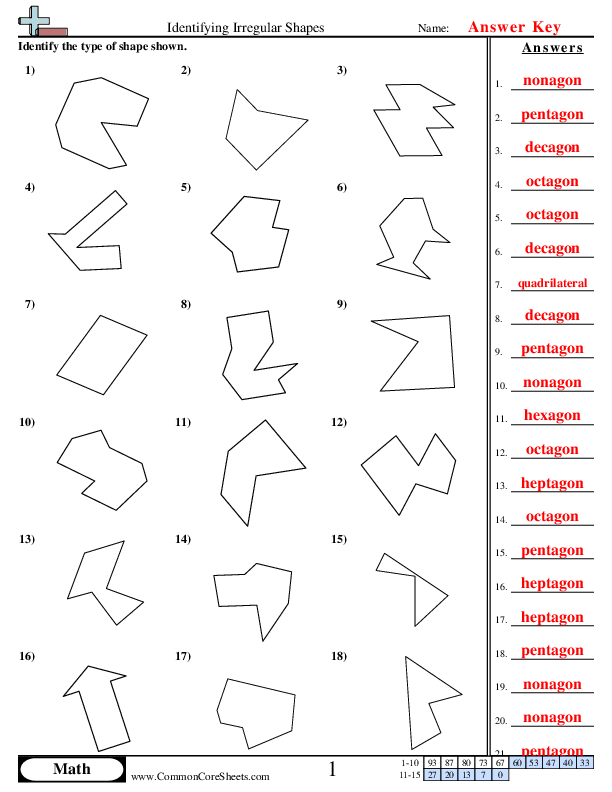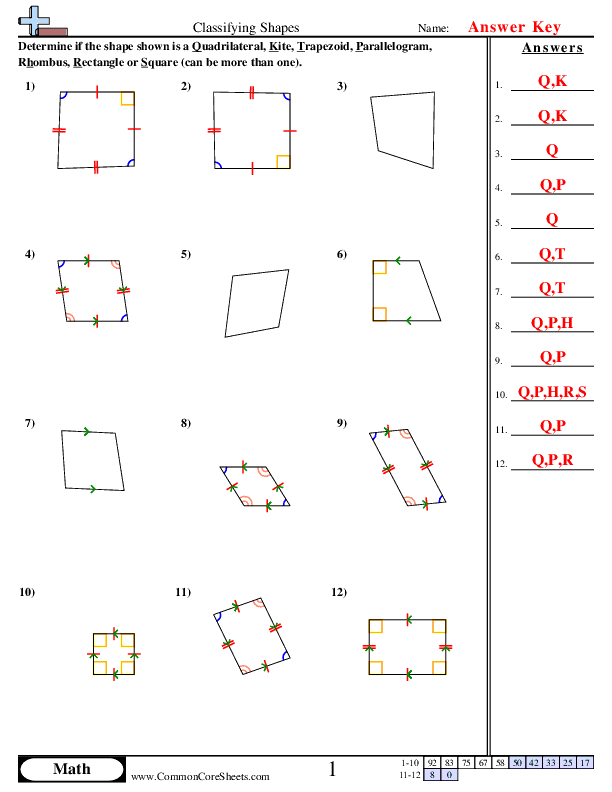Discover the best free shapes worksheets on the internet. Our worksheets help children learn about reflections, translations, the number of sides for everyday shapes and more! We have a wide variety of worksheets that include shapes ranging from basic triangles to complex hexagons and octagons. With our selection, your child can practice recognizing shapes while also learning about their properties. Our worksheets are easy to use and will help your child recognize shapes in a fun environment! With common core sheets, you can be sure you’re giving your child the best learning experience around. Try out our free shapes worksheets today!
Browse Sheets By Problem Type
×
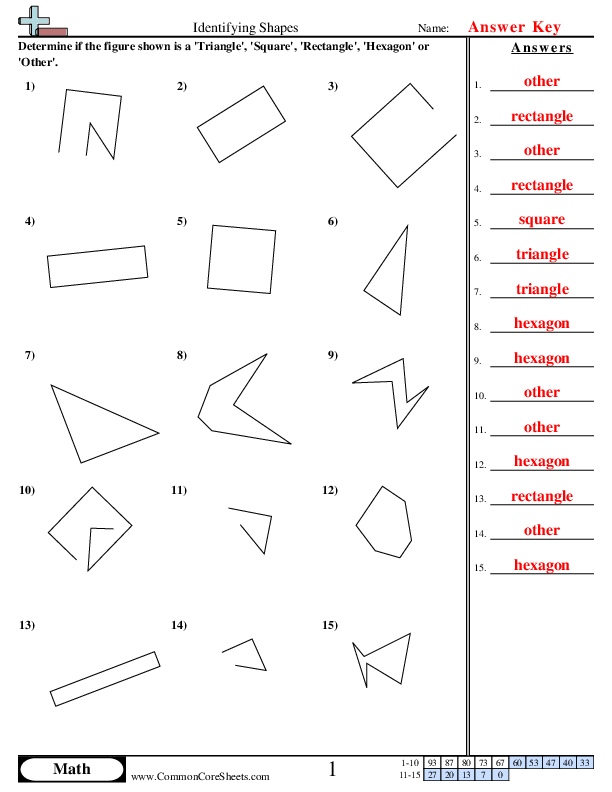
Identifying Shapes
1g1


×
Description:
"This worksheet is designed to boost math skills by teaching children to identify different shapes. Comprising 15 interactive problems, it offers an engaging and educational experience that can be customized to each individual's learning pace. The worksheet can also be transformed into flashcards or used in distance learning environments, solidifying knowledge through diverse teaching methods. Perfect for cultivating an understanding of basic geometry concepts in a fun and simplified manner."

×
Student Goals:
Shape Recognition SkillsUpon completion of this worksheet, students should have drastically improved their ability to identify and distinguish between various geometric shapes. They will be able to recognize common shapes like rectangles, squares, circles, and triangles, as well as more complex ones like pentagons, hexagons, and octagons. This is a fundamental ability that forms the basis of many other mathematical skills and concepts.Mathematical VocabularyStudents will also have expanded their mathematical vocabulary. They will be familiar with specific terms relating to shapes, such as vertex, edge, and face, along with understanding what is meant by sides and corners. This knowledge of terminology will help them to accurately describe shapes and their properties, expanding their mathematical communication skills.Analytical and Problem-Solving SkillsBy solving the shape-based problems, students will have honed their analytical and problem-solving skills. They will have practiced observing patterns and making predictions, and they’ll be more comfortable with applying deductive reasoning. These skills are crucial in many areas of life beyond mathematics.Understanding of Shape PropertiesFurthermore, students should have a solid understanding of the unique properties that differentiate various shapes. They should be comfortable discussing the number of sides a shape has, whether its sides are equal, and whether angles are acute or obtuse. This more advanced understanding will set the stage for further study in areas like geometry and trigonometry.Confidence and Enjoyment in LearningLastly, the successful completion of the worksheet will boost their confidence in their mathematical abilities. This increased confidence, combined with the satisfaction of solving problems, will help to foster a greater love of learning and a positive attitude toward mathematics, which can have an extremely beneficial impact on their future academic success.


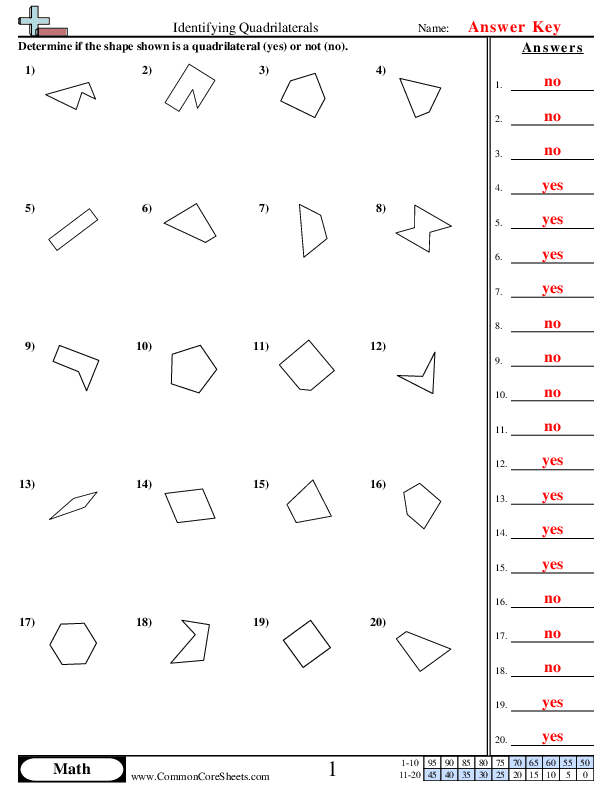
Identifying Quadrilaterals
2g1


×
Description:
"This worksheet is designed to immerse children in the subject of math, specifically identifying quadrilaterals. It contains 20 engaging problems that encourage the exploration of geometric shapes. Targeted for use in distance learning environments, the content can be customized according to the learner's pace and level. Additionally, the problems can be converted into flash cards for a more interactive learning experience."

×
Student Goals:
Mathematics Skills DevelopmentUpon completion of the 'Identifying Quadrilaterals' worksheet, students should have advanced their mathematics skills. They should exhibit stronger understanding and comprehension of fundamental concepts in geometry, particularly regarding quadrilaterals. This means, they can define, analyze, and classify varying quadrilateral types with ease, exhibiting an understanding of their properties and characteristics.Critical Thinking and Problem SolvingStudents should demonstrate improved problem-solving abilities and critical thinking. Solving a diverse range of problems related to quadrilaterals, they are expected to apply logical reasoning, deduction, and abstraction. This implies they can identify different types of quadrilaterals and their key properties by analyzing the angles, sides, and other relevant characteristics.Align with Curriculum StandardsCompleting the worksheet should assist learners in aligning with the standard curriculum requirements for their respective grade level in mathematics, specifically concerning the topic of quadrilaterals. This should provide impetus toward mastery of crucial curriculum areas, thereby setting a solid foundation for tackling more complex geometrical topics later in their academic progress.Confidence BuildingStudents are expected to gain increased confidence in their mathematical capabilities through the completion of the worksheet. The successful identification and classification of quadrilaterals would endorse their learning progress, build self-assurance and encourage self-led learning. This can be a significant accomplishment as the confidence gained can translate into better performance in other areas of their academic lives.Preparation for Advanced TopicsAfter successfully identifying and understanding different quadrilaterals and their properties, students will be well-prepared for more advanced geometry-related topics. Whether it's studying specific quadrilateral properties, relationship between angles and sides, or progressing towards complex figures and 3D shapes, the worksheet serves as a stepping stone to more advanced mathematical topics.


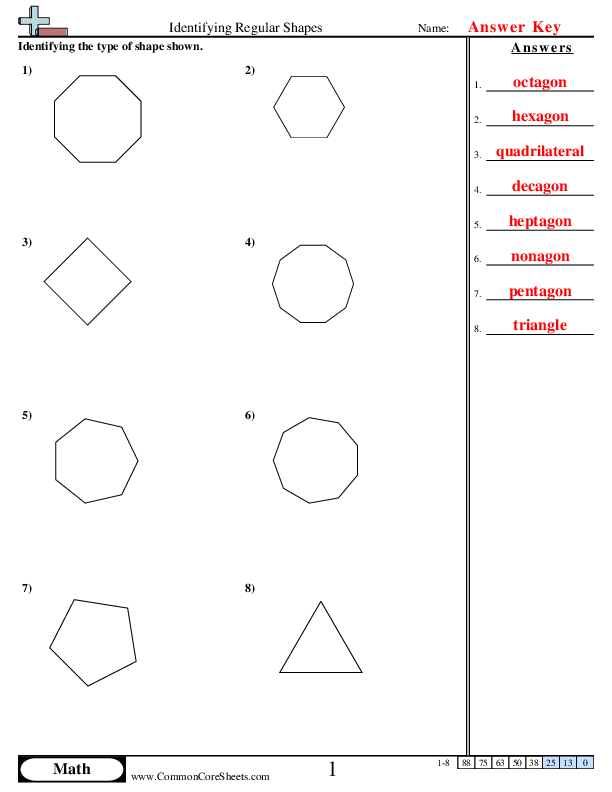
Regular Shapes (3,4,5,6,7,8,9 & 10 sides)
3g1


×
Description:
"This worksheet is designed to facilitate children in identifying regular shapes in a playful manner. Comprising 8 interactive math problems, it encourages cognitive development through shape recognition while promoting mathematical competence. This versatile worksheet can be customized according to individual learning styles, converted into flashcards for memory enhancement, and is highly suitable for distance learning. Help your child hone critical thinking skills with this engaging math activity."

×
Student Goals:
Shape RecognitionAfter completing the Identifying Regular Shapes worksheet, students should have strengthened their ability to recognize and identify different regular shapes. They will have developed a keen eye for distinguishing between various geometric forms, an essential skill foundational to more advanced mathematical concepts.Critical ThinkingThe worksheet will enhance the child's ability to analyze and compare objects based on their shape, driving the development of critical thinking skills. By differentiating between various regular shapes, students will be exercising reasoning and critical problem-solving abilities.Mathematical KnowledgeBy navigating through this worksheet, students will reinforce their knowledge on shapes' properties and characteristics. This understanding will form a solid basis for their future engagement with complex geometric principles and mathematical operations. Further, the learned concepts can extend to many practical applications in daily life.Visual Spatial SkillsParticipating in shape identification activities like this worksheet helps students refine their visual-spatial skills. This ability is critical in interpreting the world around them including managing spatial coding and distance, important for both mathematical understanding and daily navigation.Application SkillsWith sharp skills in identifying regular shapes, students are better equipped to apply these concepts in different contexts. They should be able to identify shapes in various orientations, conditions, and composite forms, thus demonstrating an understanding of the subject beyond its theoretical aspects.Confidence In Problem-SolvingSuccessfully identifying regular shapes on the worksheet can help children build confidence in their problem-solving abilities. Undoubtedly, this confidence will not only motivate them to explore more complex aspects of mathematics but also to tackle challenges in other subjects.Vocabulary ExpansionThis worksheet would have contributed to the student's mathematical vocabulary. By consistently working through the problems, they would have become familiar with terms related to regular shapes, thereby expanding their mathematical language.


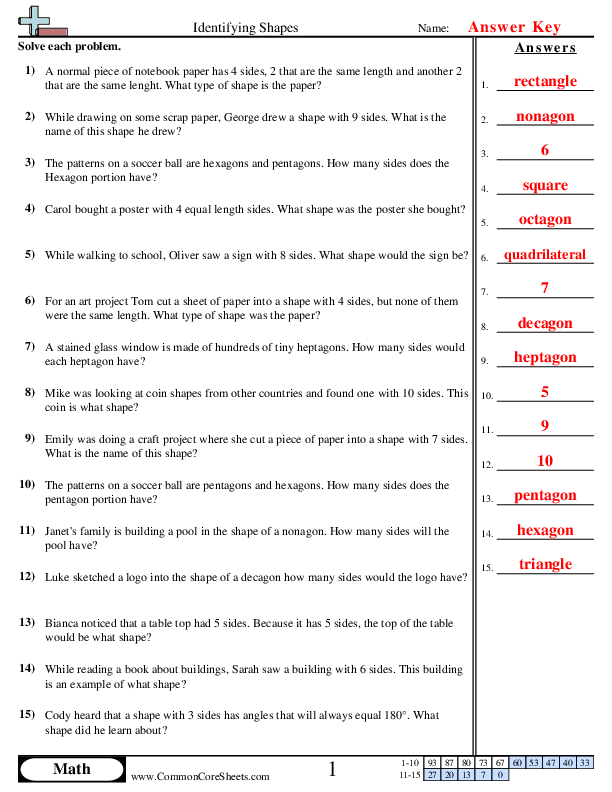
Word Problems (3 - 10 sides)
3g1


×
Description:
"This worksheet is designed to help children enhance their knowledge in math, particularly in identifying shapes based on the number of sides. Covering a range of 15 practical problems involving real-life scenarios, it encourages comprehensive geometry learning. It can be customized according to learner's needs, adapted into flash cards for more interactive learning or seamlessly integrated into distance learning programs."

×
Student Goals:
Shape RecognitionBy the end of this worksheet, students should have developed improved recognition skills for identifying various shapes by their unique characteristics, such as the number of sides each shape has. This foundational geometric understanding will prove useful across a variety of math and everyday contexts.Knowledge on Geometric PropertiesThe students are expected to be able to relate real-life objects with geometric shapes and their properties — an important step in spatial awareness. This can help them to see and understand the geometry that is embedded in our world, which could inspire them to be more creative in their thinking.Application of KnowledgeAfter successfully completing the worksheet, students should be able to apply their knowledge of shapes to practical scenarios. This could range from predicting the shape of a given object based on the number of sides described, to identifying the name of a shape by its properties. These skills can deepen their understanding of how shapes are associated with everyday items.Enhanced Problem-solving SkillsThe worksheet will help to enhance problem-solving skills. By relating shapes based on the number of sides, students are required to recall and apply geometric knowledge to solve various problems. This is a fundamental skill in mathematics that also applies in complex problem-solving scenarios.Vocabulary EnhancementPost completion, students are expected to have an extended vocabulary of specific geometric terms such as heptagon, nonagon, decagon, etc. This can enhance their communication skills especially when it comes to expressing mathematical concepts and ideas. Overall, this facilitates in making them confident in using geometry-specific terminologies in their academic pursuits as well as everyday interactions.Increased Critical ThinkingThe worksheet significantly contributes to enhancing the students' ability to critically analyze and come up with viable results. This ability will prove helpful in numerical and spatial reasoning, arming learners with the necessary skills for more advanced geometric studies. Hence, students can develop a keen eye for details which is key for solving mathematical problems.



Identifying Regular and Irregular Polygons
3g1


×
Description:
"This worksheet is designed to boost math skills by facilitating the identification of regular and irregular shapes. It contains 15 challenging problems that reinforce geometric recognition. Flexible and versatile, this resource can be customized to suit individual learning preferences, transformed into practical flashcards or effortlessly included in distance learning. Encouraging active learning, it forms a perfect foundation for understanding critical geometry concepts."

×
Student Goals:
Understanding ShapesOnce the worksheet is completed, students should have a solid grasp on the differentiation between regular and irregular shapes. This includes understanding the traits that differentiate these two shape categories and being able to confidently classify a variety of shapes independently.Developed Observational SkillsThe practice problems on this worksheet help students to hone their observational skills as they carefully examine each shape to determine its classification. By closely observing each shape's attributes, students further develop these important cognitive skills necessary not just in mathematics but in other academic disciplines as well.Improved Mathematical VocabularyBy labeling shapes as either regular or irregular, students expand their mathematical vocabulary. Understanding and using these terms correctly helps students to internally organize their understanding of shape categories and sets a solid foundation for future geometric studies.Mastery of Fundamental Math ConceptAfter completing this worksheet successfully, students can be confident they have mastered a fundamental math concept that is prerequisite for higher-level geometric studies. They’ll be equipped with the necessary knowledge to face more complex geometric problems in the future.Preparedness for Real-world ApplicationThe ability to identify and differentiate shapes is not only a mathematical skill, but also has great importance in real-world contexts. From architecture to art and design, a strong grasp of shapes and their properties prepares students for applying their learned knowledge beyond the classroom.Improved Problem-solving AbilityThis worksheet also guides the students to enhance their problem-solving abilities. By working through each problem and deciding whether a shape is regular or irregular, they get to engage in logical reasoning and decision-making processes, thereby improving their overall thinking skills.Promote Active LearningThrough completing this worksheet, students engage in active learning as they are not merely receiving information, but are processing and recalling it to solve problems. This encourages better retention and a deeper understanding of the concept.


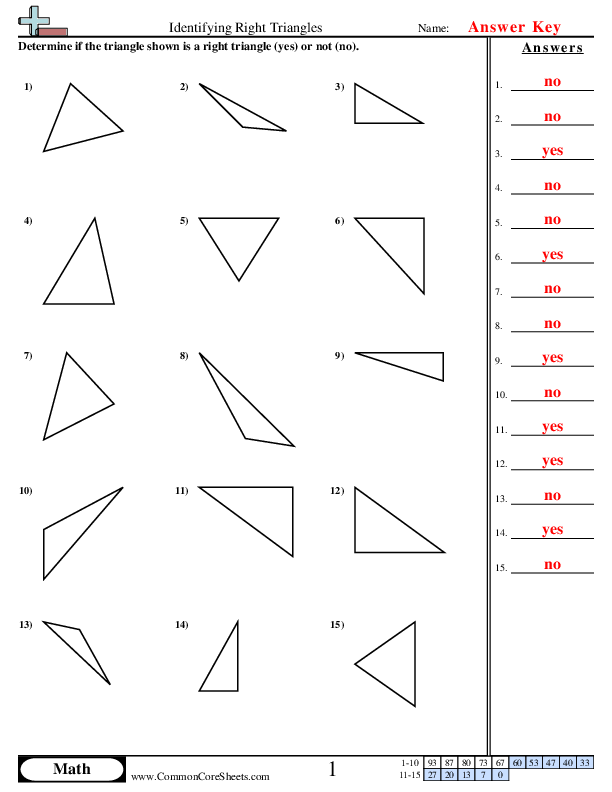
Identifying Right Triangles
4g2


×
Description:
"This worksheet is designed to help children master the concept of identifying right triangles effectively. With 15 math problems, the material drills in the key geometry concept suitable to boost them academically. The worksheet's flexibility allows it to be customized, converted into flashcards, or even incorporated as a valuable tool in distance learning, adapting to various learning styles and needs."

×
Student Goals:
Mathematical UnderstandingAfter completing this worksheet, students should display a solid understanding of the fundamental properties of right triangles. They should be able to correctly identify right triangles based on the lengths of its sides as well as the properties relating to the angles of a right triangle. Moreover, they develop an ability to integrate concept knowledge with geometric reasoning to solve problems.Problem Solving SkillsThis worksheet is designed to enhance students' problem-solving skills. The various problems presented on the worksheet require critical thinking and application of the mathematical principles learned in identifying right triangles. After completion, students should be able to approach similar problems with confidence and solve them efficiently.Real World ApplicationWith these activities, students should be able to relate the abstract mathematical ideas to practical, real-world scenarios. They would understand where and why the concept of right triangles is used in our daily life, such as in construction, navigation, design, and various fields of science. This understanding forms the basis for advanced problem solving.Preparation for Advanced StudyThe worksheet lays the groundwork for more complex mathematical concepts. After completing the worksheet, students should be prepared for understanding more intricate geometric concepts and theorems, such as the Pythagorean theorem, trigonometric ratios, among others. This paves the way for their further study in mathematics.Critical ThinkingAlong with learning the essential characteristics of a right triangle, students are also challenged to develop their critical thinking abilities. They learn to analyze different types of problems and apply suitable mathematical procedures to find solutions. They get practice in strategizing and reasoning which can be beneficial in various other academic domains as well.



Identifying Solid Shapes


×
Description:
"This worksheet is designed to strengthen children's understanding of solid figures in math. Featuring 12 engaging problems, learners will identify shapes ranging from spheres and cylinders to triangular pyramids and cubes. This versatile tool can be easily customized to match varying skill levels, converted into flashcards for interactive learning, or used flexibly in distance learning environments to enhance the student's grasp of three-dimensional geometry concepts."

×
Student Goals:
Identifying and Understanding Solid FiguresAfter completing the worksheet, students should be able to accurately identify various solid figures. This includes understanding the characteristics of spheres, prisms (triangular and rectangular), cubes, cylinders, cones, and pyramids (triangular and rectangular). By recognizing the differences among these three-dimensional figures, students will enhance their spatial reasoning - a critical skill in understanding geometry and other higher mathematical concepts.Improvement of Problem-Solving SkillsThe worksheet is structured to improve problem-solving skills. Students will be challenged to match descriptive characteristics with the appropriate solid figure. This approach encourages systematic thinking and, over time, will build confidence in mathematical reasoning, essential for complex problem-solving tasks.Enhancement of Analytical SkillsThe process of identifying the correct solid figure from a list of options will stimulate students' analytical thinking. Their ability to analyze and differentiate the characteristics of each figure forms the basis of this task. In doing so, students will strengthen their analytical skills, an important competency not just in mathematics but across multiple academic disciplines.Solidifying Core Mathematics CompetencyBy completing the worksheet, students are reinforcing their core math competency. Understanding the properties of solid figures is a key part of the mathematics curriculum and forms the foundation for complex geometric studies. Regular and repeated practice helps ensure these concepts become well ingrained and familiar to students, helping them excel in future more complex geometric tasks.Increasing Engagement with MathThe completion of the worksheet also serves to increase students' engagement with math. The activity-oriented nature of the worksheet can make learning more enjoyable, encouraging a more positive attitude towards the subject of mathematics. A positive attitude and increased engagement can lead to better attention during math lessons and improved performance.


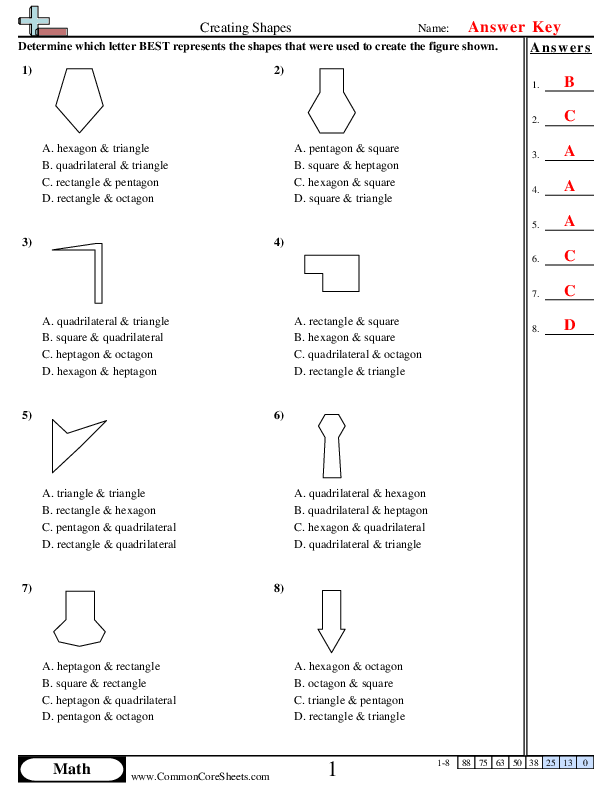
Creating Shapes


×
Description:
"This worksheet is designed to help children master their understanding of shapes in a fun and interactive way. With 8 math problems, each featuring a mix of different shapes like hexagon, rectangle, pentagon, etc., children are encouraged to identify and create combinations of shapes. The worksheet can be fully customized to suit every child's learning pace. It can also be conveniently converted into flash cards or incorporated into distance learning for a more engaging, kid-friendly experience."

×
Student Goals:
Master Different Geometric ShapesAfter completing the worksheet, students should have a mastery of various geometric shapes. They should be able to differentiate and name the common shapes such as triangles, rectangles, squares, quadrilaterals, pentagons, hexagons, heptagons, and octagons. These key concepts form the building blocks for higher geometry learning.Understand Shape AttributesStudents should be able to understand and ascertain the attributes of these geometric shapes. This includes recognising the number and types of sides, vertices, and corners each shape has. With this knowledge, students can identify a shape even if its appearance is transformed through flips, turns, or slides.Apply Knowledge to Real-World ScenariosAs students understand and learn about different shapes, they should be able to apply this knowledge to recognise these shapes in their daily life. This enhances their spatial recognition skills, a key aspect of mathematical learning. This ability to apply abstract concepts in real-world context increases their analytical thinking.Advance Mathematical ReasoningBy systematically solving the problems in this worksheet, students should have advanced their mathematical reasoning skills. They will learn how to check for correctness of their answers, a key element of critical thinking. With practice, this leads to improved mathematical intuition and accuracy in problem-solving.Enhance VocabularyCompleting this worksheet will also enhance students' mathematical vocabulary. They'll become more comfortable mentioning and discussing different shapes, aiding their comprehension skills. This is not only crucial in math, but it provides a bridge to language and communication skills too.Boost ConfidenceLastly, through consistent practice and eventual mastery of recognizing and categorizing different geometric shapes, the students' confidence in their mathematical abilities should increase. This is an essential element of math education, as confidence often leads to curiosity and long-term interest in the subject.


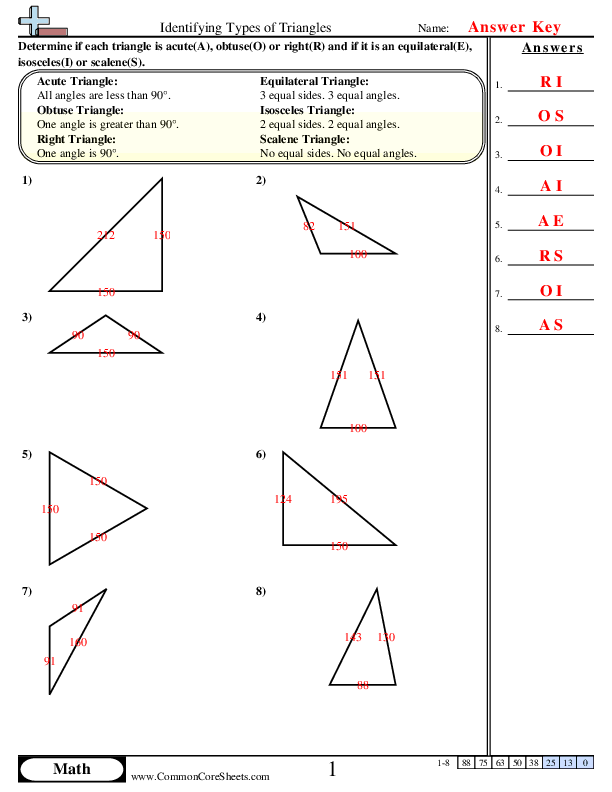
Identifying Types of Triangles


×
Description:
"This worksheet is designed to help children identify different types of triangles using angle measurements. The 8-problem math worksheet incorporates various triangle examples, suited to cater to individual learning capacities. It can be customized, transformed into flash cards and is also suitable for distance learning, ensuring versatile use and a personalized learning experience."

×
Student Goals:
Recognize Distinct Triangle TypesOneof the foremost competencies students should gain from this worksheet isimproved knowledge on the different types of triangles. This includes being able to identify and distinguish between equilateral, isosceles, and scalene triangles based on their side lengths.Application of Geometric PrinciplesHaving worked through the different problems provided, students would better understand mathematical principles related to triangles, notably the concept that the sum of lengths of any two sides of a triangle is always greater than the length of the third side.Develop Computational SkillsBy solving these problems, students would have strengthened their computational skills. This is crucial in mathematics as it forms the basis for tackling more complex problems.Critical Thinking and Problem-Solving AbilitiesThe worksheet is designed to challenge students' critical thinking skills. The process of identifying triangle types not only involves the application of geometry principles but also demands careful analysis. As such, students would develop their problem-solving abilities by the time they've completed the worksheet.Building Confidence in MathematicsUpon successful completion of the worksheet, students should feel more confident in their mathematical abilities. This can have a positive impact on their overall performance and interest in the subject.Preparation for Advanced TopicsUnderstanding and identifying different types of triangles sets a foundation for tackling more advanced topics in geometry like trigonometry. This worksheet will enable students to be better prepared for such future learning opportunities.


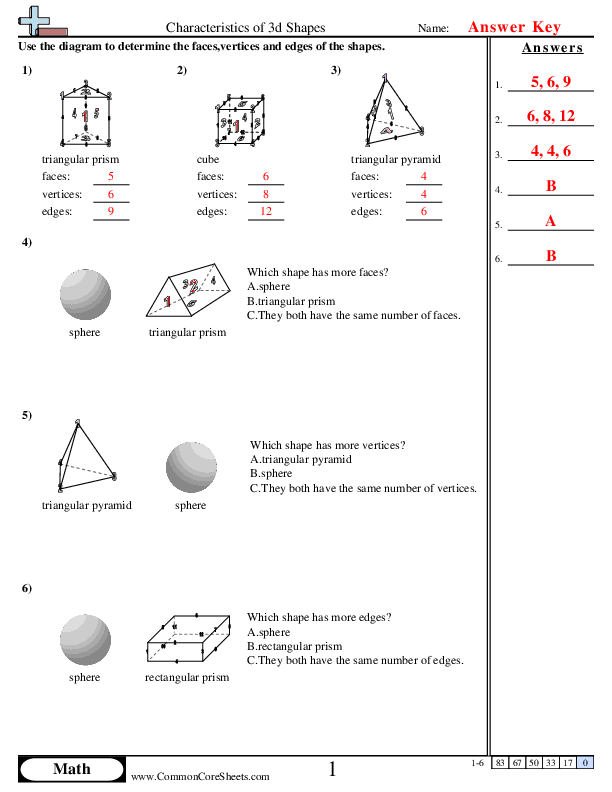
Characteristics of 3d Shapes


×
Description:
"This worksheet is designed to teach children the characteristics of 3D shapes through interactive math problems. It covers fundamental concepts such as faces, vertices, and edges on differing shapes such as pyramids, spheres, and prisms. Flexible and user-friendly, it offers six customizable problems that can be converted into flash cards for enhanced learning. It's also suitable for distance learning, providing an accessible educational resource for teachers and students alike."

×
Student Goals:
Understanding of 3D ShapesUpon the completion of this worksheet, students should have a concrete understanding of 3D shapes. They will gain in-depth knowledge about the parameters that define 3D shapes such as faces, vertices, and edges. They will realize that each shape, be it a rectangular pyramid, a triangular prism, or others, has a distinct set of parameters.Comparative Analysis SkillsWorking through the worksheet, learners will develop skills in comparative analysis. They will be required to compare different 3D shapes in terms of their faces, vertices, and edges. They will identify similarities and differences, promoting critical thinking skills.Problem Solving SkillsThe worksheet is designed to foster problem-solving skills among students. By answering the problems given, students will practice how to approach and solve mathematical problems. By determining which shape has more faces, vertices, or edges, they learn to apply their knowledge effectively.Application of KnowledgeThe problems presented evoke situations where students can apply the knowledge they have about 3D shapes. They will learn to select relevant information and use it to make accurate determinations about different shapes.Information Structure UnderstandingThis worksheet will help pupils understand that all shapes can be broken down into definable parameters, and that these can be correlated across different shapes. This will allow them to structurally assess shapes, strengthening their mathematical comprehension.Enhanced Mathematical VocabularyBy tackling problems related to 3D shapes, students will become familiar with mathematical terms associated with geometry and extend their mathematical vocabulary. They will understand and use terms such as faces, vertices, and edges.Confidence BuildingThe successful completion of this worksheet should enhance students' confidence in their ability to handle more complex 3D problems. The practice they get might make them more likely to participate in math-related activities and discussions.


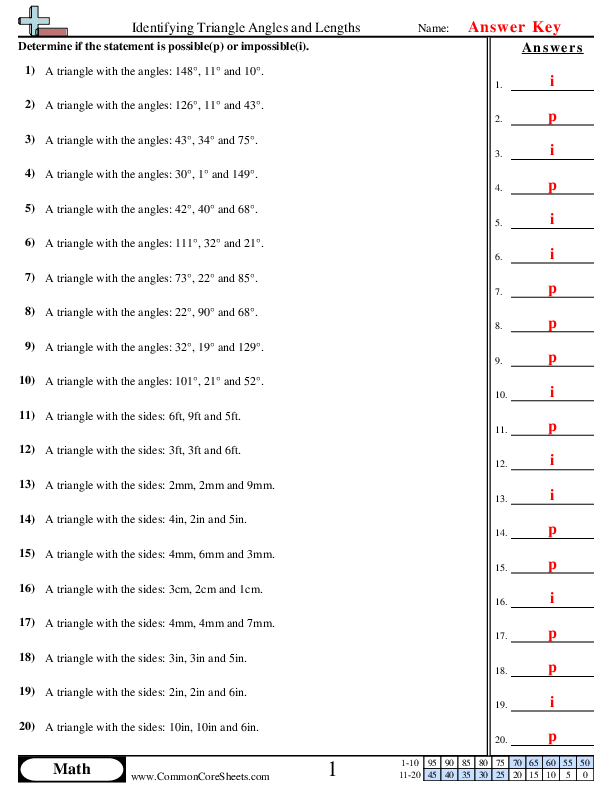
Identifying Triangle Angles and Lengths
7g2


×
Description:
"This worksheet is designed to help children grasp the basics of triangle angles using 20 math problems. Exploring concepts like identifying and adding up angles, this tool is customizable to accommodate individual learning paths. It can be transformed into flashcards for quick revisions or integrated into distance learning curriculum. An engaging approach to mastering triangular geometry."

×
Student Goals:
Deepen Understanding of TrianglesBy completing the worksheet, students will have a thorough understanding of the core geometry concept of triangles, focusing specifically on the relationship between angles and lengths of these shapes.Acquire Problem Solving SkillsWith a set of 20 problems to solve, students get ample opportunity to apply their knowledge, and in the process, sharpen their problem-solving skills. They learn to approach solutions from different angles, improving their analytical thinking.Gain Proficiency in Identifying Triangle AnglesThe worksheet contains problems requiring to identify different angles of a triangle. With constant practice, students will be able to swiftly and accurately identify triangle angles, an essential skill in the study of advanced geometry.Develop Mathematical ConfidenceSolving a variety of problems relating to triangles, students will gain greater conviction in their mathematical abilities. It builds a strong foundation that allows them to tackle more complex mathematical concepts with confidence.Master the Basics of GeometryThe problems on this worksheet pertain to fundamental geometric concepts. Students will be able to fortify their base in geometry by mastering the defining properties of triangles, preparing them for advanced geometric studies.Improve Accuracy and SpeedWith repeated exercise of identifying triangle angles and lengths, students will naturally become quicker and more exact in their calculations, pairing accuracy with speed, which is crucial in timed tests or competitive exams.Enhance Cognitive AbilitiesBy employing multiple skills such as logic, spatial awareness and pattern recognition while identifying triangle angles and lengths, students subconsciously hone their cognitive abilities that are not only critical in math, but across various aspects of education and life.



Slicing 3d Shapes
7g3


×
Description:
"This worksheet is designed to enhance children's understanding of 3D shapes in math through interactive learning. Featuring nine intriguing problems, it explores concepts involving slicing or sectioning 3D shapes. The worksheet is highly customizable, allows for conversion to flashcards, and is compatible for use in distance learning environments. A perfect tool to make math more fun and engaging."

×
Student Goals:
Understanding 3D ShapesAfter completing the worksheet, students should have heightened understanding of the structures and properties of three-dimensional shapes. Their comprehension of geometric fundamentals such as faces, edges, and vertices will be strengthened, which leads to a superior grasp on the spatial aspects in mathematics.Geometrical InsightThe worksheet will enable students to visualize the slicing or partitioning of 3D shapes, enriching their geometrical insight. They should be able to imagine the results of slicing different 3D shapes to understand the formation of new figures and recognize the relationship between the sliced and the original shape.Analytical SkillsThe worksheet aims to foster students' problem-solving and analytical capabilities. Through the practice of various problems, students will learn how to approach different math problems strategically, enhancing their critical thinking and logical reasoning skills.Practical ApplicationThis mathematical knowledge of 3D figures will encourage students to correlate with real-world objects to mathematical depictions. Hence, it will foster an understanding of the practical application of mathematics in the real world, making learning more interactive and fun.Preparation for advanced studiesMastering these fundamentals will lay a strong foundation for students as they progress in their journey of learning mathematics. This knowledge is essential as a preparatory step for future, more complex geometrical concepts including volume, surface area, etc.Boosted ConfidenceSuccessfully solving the problems on the worksheet would increase the confidence levels of the students in their mathematical abilities. This feeling of accomplishment acts as a great motivating factor and encourages further learning.Improvement in Mathematical VocabularyStudents will also learn new mathematical vocabulary and their definitions, for example, parallelepiped, polyhedron, etc. Acquiring such vocabularies is fundamental in understanding mathematical concepts in the future.


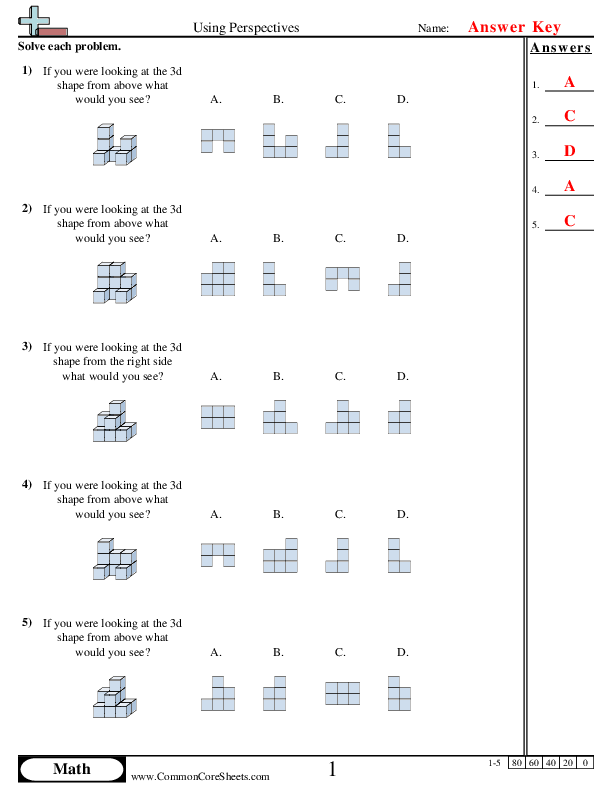
Using Perspectives


×
Description:
"This worksheet is designed to enhance children's spatial and geometrical understanding in math, by challenging them to perceive 3D shapes from different perspectives. The five tailored problems encourage analytical thinking and build visualization skills. These exercises are modifiable to suit individual learning styles and can be transformed into flash cards or integrated into distance learning formats, supporting diverse and flexible math education."

×
Student Goals:
Understanding of PerspectivesAfter completing the worksheet, students should have developed a keen understanding of perspectives, specifically, how the appearance of objects can change based on the angle or position they are viewed from.Spatial AwarenessThis 'Using Perspectives' worksheet will help children boost their spatial awareness. This crucial skill will allow them to grasp the concept of three-dimensional shapes better, and understand how to depict them from different angles or perspectives. They will be able to recognize and mentally manipulate objects, improving their ability to think in three-dimensions.Problem-Solving SkillsThrough the five problems on the worksheet, students will enhance their problem-solving skills. They will learn to approach questions from different viewpoints, not just physically, but mentally as well. Navigating through these problems will sharpen their skill in strategic thinking and patience.Visualization SkillsThis activity will significantly enhance students' visualization skills. They will be able to form mental images and visualize different scenarios or perspectives of the 3D shapes presented. This ability to 'see' objects with the mind's eye is important in not just math, but other subjects like science or arts.Improved Confidence in MathTackling problems from this 'Using Perspectives' worksheet will also help boost students' confidence levels in math. By understanding how to handle 3D objects and navigate through different perspectives, students can better comprehend and solve more complex mathematical problems. Moreover, it sets the foundation for more advanced topics in geometry and algebra.Preparation for Advanced ConceptsFinally, this worksheet will prepare students for more advanced math concepts. Understanding perspectives is crucial in geometry, engineering, and even in arts and design subjects. Therefore, getting a good grasp on this concept will provide them with a base that will be invaluable in their further education.


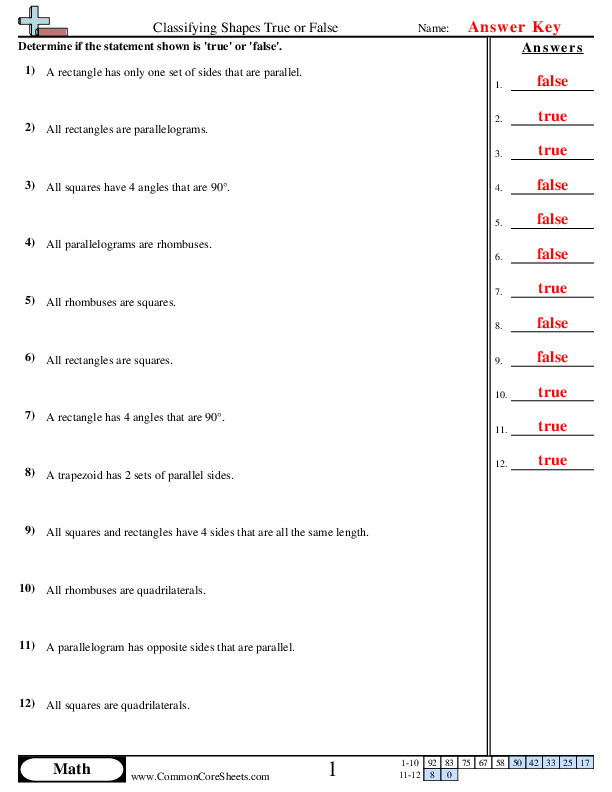
Classifying Shapes True or False
5g3


×
Description:
"This worksheet is designed to instruct young minds on the distinguishing features of various geometric shapes. With twelve true or false questions, concepts include identifying properties of squares, rectangles, parallelograms, and trapezoids. It's a versatile tool that can easily be adapted for distance learning, converted to flashcards, or tailored to individual learning needs, reinforcing mathematical understanding and fostering problem-solving skills."

×
Student Goals:
Improved Understanding of ShapesUpon completing the worksheet, students should have a comprehensive understanding of various shapes and their properties. The ability to distinguish between squares, rectangles, trapezoids, rhombuses, kites, and quadrilaterals will be enhanced. Students will understand that shapes can share certain properties while differing in others, enabling them to discern subtle distinctions between similar-looking shapes.Enhanced Critical Thinking SkillsThis worksheet requires students to decide whether statements are true or false, thereby encouraging critical thinking. They need to recall the characteristics of each shape and apply this knowledge to assess the accuracy of each statement. Consequently, their analytical skills will be greatly improved.Applied Mathematical KnowledgeStudents will apply their theoretical understanding of shapes to practical problems. By critically analyzing each statement, they will demonstrate their ability to apply mathematical concepts to real-world situations. This will help in fostering their problem-solving capabilities and will ensure they can apply theoretical mathematics to practical scenarios.Developed Accuracy and PrecisionTo correctly identify the veracity of the statements provided, students will need to exercise precision and accuracy. This will encourage attention to detail and patience as they review each statement with care.Expanded VocabularyBy completing the worksheet, students will enlarge their mathematical vocabulary, equipping them with the necessary terminology to articulate shape properties and relationships. They will become adept at using specialist terms such as 'quadrilateral', 'parallelogram', and 'rhombus' in the correct context, fostering effective communication in the field of mathematics.Confidence BoostSuccessfully completing the worksheet will result in an increased confidence in their mathematical abilities. This will foster a love for the subject and will encourage them to tackle more challenging problems related to shapes and their properties.



Classifying Shapes (Multiple Choice)
5g3


×
Description:
"This worksheet is designed to assist children in mastering the classification of shapes, particularly quadrilaterals. The engaging, math-oriented worksheet includes 7 multiple-choice problems, each with unique qualities of different polygons. It is a versatile tool for education, suitable for customization, conversion into flashcards, or incorporation into distance learning. The main focus is deepening the understanding of diverse quadrilateral properties."

×
Student Goals:
Shape IdentificationAfter completing the worksheet, students should have developed the competence to effectively classify and identify different types of quadrilaterals based on their properties. They should be able to distinguish between squares, rectangles, rhombi, trapezoids, and kites by examining their angles, side lengths, and the parallelism of their sides.Analytical SkillsThis worksheet will also hone the students' analytical skills, imparting them with the ability to objectively analyze the given problem not just on the surface, but by delving into its details. Students will learn to dissect the question, focusing on the angle measures, side lengths, and the parallelism or lack thereof of the sides to determine the correct answer.Problem Solving TechniquesUpon completion of this worksheet, learners should have enhanced their problem-solving techniques. They will acquire the ability to apply their theoretical knowledge of 2D shapes into practical scenario by solving multiple choice questions. Through repetition and practice, they will become adept at using guided strategies to identify various quadrilaterals.Critical ThinkingThe worksheet is designed to bolster critical thinking abilities amongst students. By differentiating between properties of various shapes, students will be led towards developing a systematic method of eliminating incorrect options, enabling them to choose the right one. Such deductive reasoning skills are pivotal in enhancing their academic growth and can be applied to other facets of their learning as well.Confidence in GeometryLastly, successful completion of the worksheet should instill in students a strong sense of confidence in their understanding of Geometry, specifically quadrilaterals. They will gain the assurance that they can accurately classify and identify these shapes based on their key properties. This newfound confidence can encourage them to delve deeper into the subject, preparing them for more advanced mathematical concepts in the future.


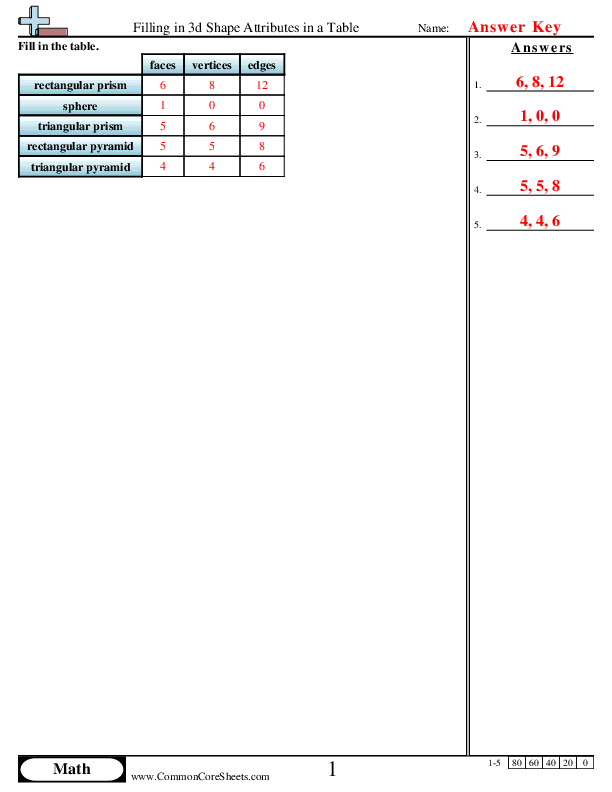
Filling in 3d Shape Attributes in a Table


×
Description:
"This worksheet is designed to help children sharpen their math skills by identifying attributes of various 3D shapes, like prisms and pyramids. With five interactive problems, learners explore dimensions such as edges, vertices, and faces. Highly customizable, the worksheet offers flexibility and can be converted into flashcards for memorization. It's an ideal tool for distance learning, fostering independent study while promoting active engagement with geometric concepts."

×
Student Goals:
Understanding 3D ShapesAfter completing the worksheet, students should be able to identify and describe various 3D shapes including rectangular prisms, rectangular pyramids, triangular prisms, spheres, and triangular pyramids. They should become familiar with the characteristics and attributes of these different 3D shapes. This will instigate the recognition and understanding of geometric concepts in their 3-dimensional forms, which is fundamental to their mathematical learning progress.Numeracy Skills EnhancementSolving the problems in this worksheet will practice the students' numeracy skills. Counting and figuring out the numbers of faces, edges, and corners for each 3D shape will facilitate their number sense and boost arithmetic skills. It will reinforce the idea that mathematics is not just about calculation but also about understanding patterns, relationships, and properties of numbers and shapes.Developing Analytical ThinkingThis worksheet will stimulate analytical thinking among students. They will need to analyze each 3D shape's attributes and correlate them with the properties of the shape. This will not only foster their geometry understanding but also cultivate logical and analytical thinking abilities. Following this pattern, they will learn to draw valid conclusions from presented information, an invaluable skill in their academic and problem-solving pursuits.Spatial Reasoning DevelopmentStudents will develop spatial reasoning after working through this worksheet. Recognizing 3D shapes, as well as their faces, edges, and vertices, requires a certain level of spatial awareness and visualization. This mental exercise will strengthen the students' capabilities of spatial reasoning, which is beneficial for many math problems and everyday life scenarios.Promotion of Independent LearningThe worksheet encourages independent learning among students. As they fill in 3D shape attributes in a table individually, they are actually being guided to self-explore and self-learn. This enables them to become active learners who control their own learning progress. It motivates them to undertake further explorations and facilitates establishing their confidence and capabilities in autonomous learning.



Characteristics of 3d Shapes (Word)


×
Description:
"This worksheet is designed to bolster kids' understanding of 3D shape characteristics. It tackles key math concepts involving the vertices, faces, and edges of various shapes, such as cubes, spheres, rectangular pyramids, and prisms. Perfect for distance learning, each of its 18 problems can be customized or converted into flashcards for interactive study."

×
Student Goals:
Understanding 3D ShapesAfter completing the worksheet, students should have a deeper comprehension of characteristics of three-dimensional shapes. They will be able to distinguish between various 3D shapes based on their properties like faces, edges, and vertices. Beyond visual identification, students should also have built a strong vocabulary and understanding of key metrics associated with 3D figures.Critical ThinkingThis worksheet is designed to improve students' critical thinking abilities. By engaging with these problems, they should be able to enhance their problem-solving skills, logical reasoning, and analysis. Students will learn to apply their theoretical understanding of 3D shapes to specific questions, thereby improving their ability to connect abstract concepts with situational problems.Application of KnowledgeStudents should be able to apply their newly acquired knowledge in various contexts. Demonstration of practical application may include the ability to identify 3D shapes in their surrounding environment or linking 3D shapes to real-world problems. This skill will further help students in seeing the relevance and importance of the math subject beyond classroom walls.Mathematical CommunicationBy completing the problems in the worksheet, students should be able to efficiently articulate mathematical ideas, reasoning, and their thinking process. They should get comfortable with math terminology associated with three-dimensional shapes and be proficient in utilizing them in appropriate contexts. This practice will help improve their mathematical communication, aiding them in expressing complex mathematical concepts easily and correctly.Confidence in MathCompleting this worksheet will help foster a positive attitude towards math. Correctly answering the problems will enhance their confidence in understanding and tackling mathematics. This confidence can help alleviate any math anxiety and stimulate a proactive learning attitude, encouraging them to explore more complex topics in math.


Shape Transformations
Link
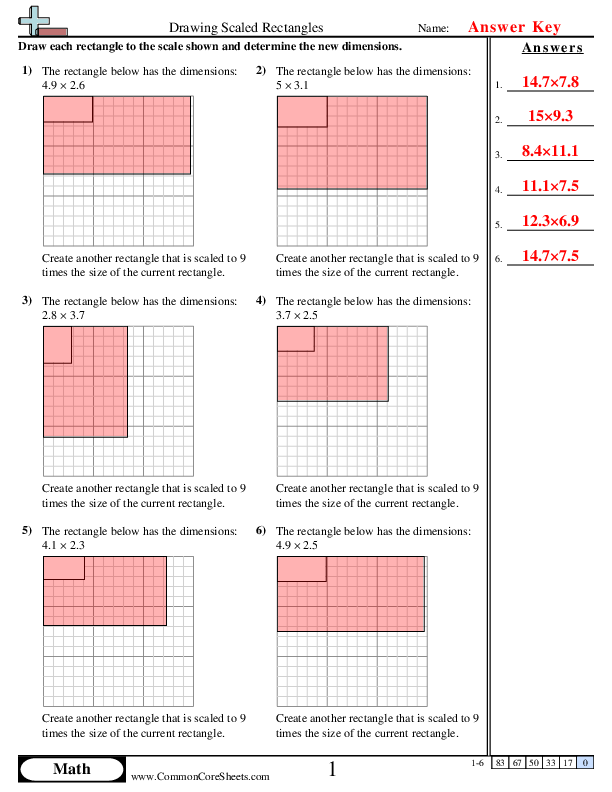
Drawing Scaled Rectangles
7g1


×
Description:
"This worksheet is designed to guide children in mastering the concept of scale in mathematics by drawing scaled rectangles. It contains six practical problems where students work with dimensions to create rectangles scaled up by different factors. The customizable worksheet is ideal for distance learning, and the content can also be converted into flash cards for convenient learning. It blends problem-solving with creativity, making math fun and engaging."

×
Student Goals:
Understanding of Scaled DimensionsUpon completing the worksheet, students should be able to understand the concept of scaling in geometry. Specifically, they will be able to comprehend how altering one dimension of a rectangle affects the overall scale of the figure. This skill requires a clear understanding of how linear measurements interact with each other in a two-dimensional plane, which is a fundamental aspect of spatial awareness and geometric understanding.Calculation of Size IncreaseStudents will also gain proficiency in calculating size increases. They will be capable of determining how a rectangle's dimensions change when it's scaled up by a specific factor, reinforcing core multiplication skills. The problems pose real-world scenarios that students may encounter in fields that utilize geometry, such as engineering, architecture, or design.Problem Solving and Critical ThinkingBy working through these rectilinear problems, students also exercise their problem solving and critical thinking abilities. They learn to apply their math knowledge to unique settings, challenging them to think creatively and logically. These are essential skills that apply to a wide array of contexts beyond math, helping to prepare students for future academic and professional challenges.Enhanced Mathematical CommunicationAs students determine the scaled rectangles' dimensions, they are expected to communicate their understanding effectively. They can do this by accurately writing or explaining the dimensions of each rectangle. This practice helps deepen their understanding of the mathematical concept and develop their ability to explain mathematical ideas — an important component of comprehensive math literacy.Application and Transfer of SkillsFinally, students will be able to transfer and apply these skills into other areas of mathematics and their daily life. Understanding how to manipulate the sizes of shapes is not just important within the realm of geometry, but also in many practical situations such as reading maps, designing a garden, or coding a video game. Through this worksheet, students are not only able to accomplish a much deeper understanding of geometry, but develop practical life skills as well.



Rotating, Reflecting & Translating


×
Description:
"This worksheet is designed to help children master shape transformation in math. It offers 15 problems, each exploring varied concepts of shape shifting. The worksheet is fully customizable, perfect for converting into flash cards or integrating into distance learning. Enhance your child's learning experience with this interactive tool."

×
Student Goals:
Shape Recognition and UnderstandingAfter completing the worksheet, students should have a heightened understanding and recognition of various shapes. They will be familiar with identifying several shapes and their key properties. This foundational knowledge will assist them in making geometrical judgments and comparisons.Transformation KnowledgeBy working through the problems in the worksheet, students will gain important knowledge regarding shape transformations. The proficiency in geometry, especially in understanding transformation actions like translation, rotation, and reflection, will be noticeably improved. They will be equipped to perform and recognize these actions in simple to complex geometrical scenarios.Reasoning and Problem SolvingThe worksheet has challenging problems that help the students to improve their ability to solve problems, reason mathematically and develop their critical thinking skills. By interpreting and analyzing each problem, they learn to adapt various problem-solving strategies, giving them the ability to solve not only similar problems but also apply these skills in different mathematical contexts.Mathematical Language and CommunicationCompleting the worksheet will enhance students' mathematical communication skills. They will become more confident in using precise mathematical language to express mathematical ideas clearly, orally, visually, and in writing. They will be capable of interpreting and mapping visual and written information, and they can communicate mathematical problems and solutions in a systematic and logical manner.Independent and Group LearningThe worksheet will encourage both independent and cooperative learning among students. It will bolster self-learning as they must analyze and find solutions independently, and also aid group study as they can collaborate and discuss their solutions and strategies on these problems. This, in consequence, improves their collaborative skills, leadership skills, empathy, respect, and understanding.Application of Mathematical KnowledgeOnce the worksheet is completed, students will be able to apply the acquired knowledge about shape and transformations to real-life situations and problems. They will be able to understand the relevance and application of their learning beyond the classroom, making them more adaptive to real-world challenges and, at the same time, enhancing their learning experience.



Identifying Similar and Congruent Shapes


×
Description:
"This worksheet is designed to help children master the concept of identifying similar and congruent shapes in mathematics. Comprising of 16 unique problems, it offers interactive and engaging content that bolsters children's spatial skills. Adaptable to various learning formats, this worksheet can be customized, transformed into flash cards, or employed within a distance learning environment to meet individual learning needs."

×
Student Goals:
Shape IdentificationUpon completion of this worksheet, students should possess a firm understanding of the concepts of similar and congruent shapes. They should be able to identify and differentiate between similar and congruent shapes. With acquired knowledge, they will have the ability to recognize these types of shapes not just in the context of this worksheet, but in any mathematical problem they encounter going forward.Mathematical ReasoningSuccessfully completing this worksheet will equip students with improved mathematical reasoning skills. They will know how to apply logic and systematic thinking while solving problems related to congruence and similarity of shapes. This will lead to the development of a critical skillset, forming the basis for many topics to follow in their mathematical journey.Problem Solving SkillsWorking through the problems in this worksheet will also enhance the students' problem-solving skills. The application of various problem-solving strategies tailored to answer each question will enable them to handle similar situations in more complex scenarios at later stages. Moreover, this exercise will familiarize them with different types of problem structures, refining their ability to decipher and address multiple problem formats.Real-life ApplicationThis worksheet will help students realize the practical applications of mathematical concepts in daily life. By identifying similar and congruent shapes correctly, they will be able to see these shapes in the world around them. The knowledge they gain will make mathematics more tangible and relatable, sparking interest and promoting a better understanding of how math applies to their everyday experiences.Enhanced ConfidenceFinally, students who complete this worksheet will gain increased confidence in their mathematical abilities. As they successfully identify similar and congruent shapes, their self-assurance in their ability to understand and implement mathematical concepts will grow. This confidence will serve as a stepping-stone to tackling more complex mathematical concepts in the future, paving their path in their mathematical education journey.


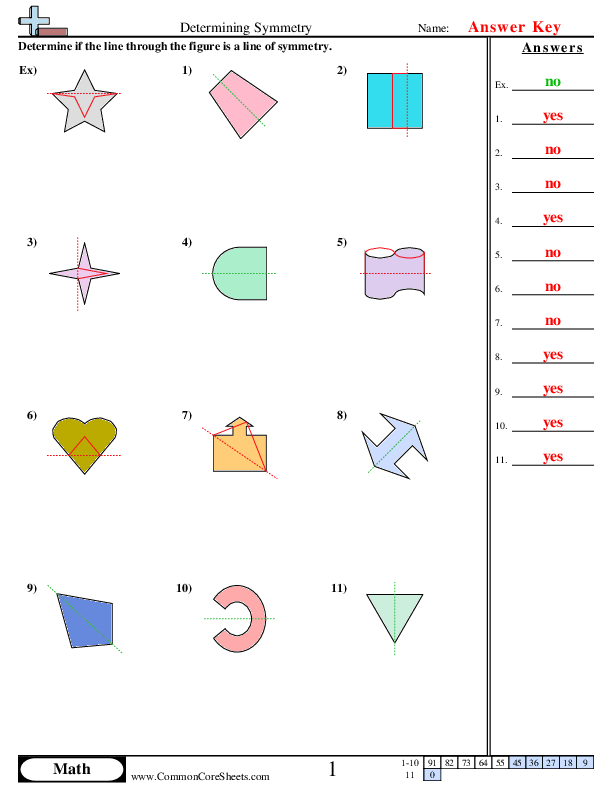
Determining Symmetry
4g3


×
Description:
"This worksheet is designed to help children grasp the concept of symmetry in math. It includes 11 problems that challenge their understanding and analytical abilities. Ideal for distance learning, this math tool not only serves as a worksheet but also be customized and converted into flashcards. The versatility of this resource makes it a great asset for educators teaching the symmetry theme in a fun, engaging manner."

×
Student Goals:
Math Skill DevelopmentUpon the completion of this worksheet, students will enhance their overall math skills. The math exercises in this worksheet are specially crafted to train young minds in a fun and engaging way. They will be able to solve math problems with more speed and efficiency, thus making them ready for more complex challenges as they progress in their academic journey.Understanding of SymmetryThe main objective of the worksheet is to develop a thorough understanding of symmetry, a fundamental concept in geometry. After completing the exercises, students will gain a comprehensive understanding of symmetry including what it means for an object to be symmetrical, how to identify symmetrical shapes and patterns, and how to apply the concept of symmetry in real-world situations.Problem-Solving AbilityThe series of problems in the worksheet requires analytical thinking and a problem-solving approach. By successfully tackling these, the kid's problem-solving abilities will significantly grow. This may help them become more proficient in Mathematics and help nurture their logic and reasoning skills.Ability to Follow InstructionsWhile completing the worksheet, the students will learn to follow instructions accurately. Each instruction in the worksheet is presented concisely and clearly, designed to foster their independent learning ability. The ability to correctly follow instructions is an essential skill that impacts the student’s learning throughout their academic life.Boost ConfidenceSuccessfully completing this worksheet will also contribute significantly to the students' confidence. Each unit successfully completed gives students a boost of confidence which is critical in the learning process. This improvement in self-confidence can spill over into many other aspects of their academic and personal lives.Preparation for Advanced LearningCompletion of this worksheet offers a solid foundation for advanced learning. As students move to higher grades, they will find that a deep understanding of concepts like symmetry is critical to progress. Thus, completing this worksheet with due diligence can set them on the right path for future learning in the field of Mathematics and beyond.





